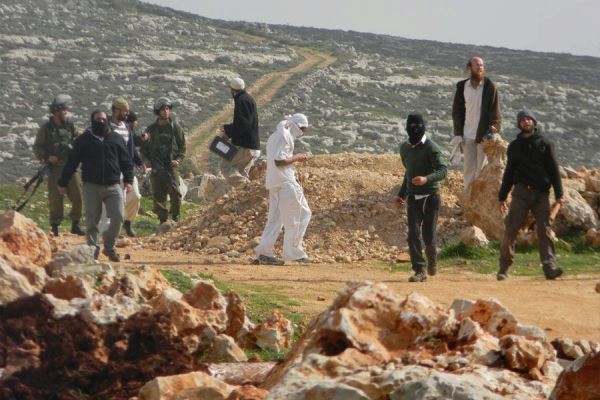When the prosecution closes a case for lack of evidence, despite the abundance thereof, we realize how seriously it takes its role.
By Yesh Din, written by Yossi Gurvitz
The location was Qusra, a village in the Shiloh Valley; the date, September 16, 2011. Fathallah Mahmoud Muhammad Abu Rhoda went out with his three sons to pick figs. A short while after reaching their land, they noticed about 10 Israeli civilians standing around their water hole. The Palestinians demanded the Israelis leave the place; the interlopers refused. The residents of Qusra — a village that has already proven it can defend itself against marauders — began heading to the area. An argument ensued, and according to Abu Rhoda’s testimony to the police, three of the settlers (who were armed) opened fire on the Palestinians. One bullet hit Abu Rhoda in the thigh.
Of the three, two were armed with rifles and the other with a handgun. From the police testimony, we see that the handgun’s owner also sicced a dog on the Palestinians. The complainants managed to photograph some of their attackers, among them the handgun owner.
Four days after the incident, Abu Rhoda filed a complaint with the police. Almost three years later, on August 6, 2014, the prosecution informed Yesh Din that it closed the case for lack of evidence. After a series of 14 phone calls, we managed to photocopy the case file on December 15 2014 — more than four months after the case was closed. However, it was immediately apparent some of the material was missing. We continued requesting it until February 2015.
From the evidence we finally received, it turns out that there is more than enough evidence to indict the handgun owner, E. As previously mentioned, E. was identified by the Palestinian victims, and they even supplied the police with photos of him at the scene, which clearly show him holding a handgun in one hand and the dog in the other. The police picked up cartridges from the scene, and a ballistic fingerprinting – which took place on September 27, 2011 – found that one of the cartridges came from a 9mm Glock pistol (the others were fired from rifles.) E. was summoned for questioning, invoked his right to remain silent, but admitted he owned a Glock. The gun was duly turned over to the police, which sent it to a ballistic fingerprinting. In February 2012 the forensic expert reached the conclusion that there is a match between the cartridges fired from E.’s handgun and the those that were examined on September 27.
In total, the following evidence was marshalled against E.
A. He was identified and photographed by the complainants.
B. His handgun was identified as a the one fired during the incident.
Despite the evidence, the police recommended that the case against E. be closed due to — get this — lack of evidence. The recommendation was accepted by the prosecution. Embarrassingly, the prosecution admitted this to us only in January 2015 — 10 months after it closed the case for lack of evidence. Only as a result of our request for more case files did the prosecution learn about the September 2011 memorandum, which identified the type of handgun owned by E. That is, when the prosecution decided to close the case for lack of evidence, it was lacking a major piece of evidence.
What about the two other shooters? I’m glad you asked. The police chased one of the suspects into the Esh Kodesh outpost, even so much as detaining him after he fled. However, despite the fact that the suspect fled arrest and refused to identify himself, there is no indication in the material we received from the police that any investigative action was taken against him. There is, for instance, no sign that he was even interrogated or gave testimony; he was detained, and immediately released.
The third suspect managed to flee in a vehicle and reach Esh Kodesh. The police identified the owner the vehicle as well as another person who was with him in the car during the chase. But, lo and behold, the police neither bothered to interrogate them nor attempt to identify the third shooter.
This is how the police and the prosecution treat a violent incident, in which three Israeli civilians open fire on Palestinians who are on their own land. In a case that contains such clear forensic evidence, they managed, with extraordinary negligence, not to notice it. And in the other cases? They simply do not investigate.
In the beginning of March, our attorney Anu Deuel Lusky (briskly aided by Moriyah Shlomot) appealed the decision, asking the prosecution to bring E. to trial and conduct further investigations that would lead to the capture of the other two suspects. To quote the appeal:
“This appeal, in both its parts, raises a harsh and heavy feeling that both the police and the prosecution betrayed their duties as bodies entrusted with maintaining law and order. The current situation – in which the lives, bodies and property of Palestinians, considered protected persons by international law, can be harmed with impunity, both as a result of settler violence and as a result of law enforcement entities standing aside, not making the minimal effort to bring lawbreakers to justice – is intolerable, and undermines the rule of law.”
“>One wonders what is left of the rule of law after it has been so brazenly undermined.
Written by Yossi Gurvitz in his capacity as a blogger for Yesh Din, Volunteers for Human Rights. A version of this post was first published on Yesh Din’s blog.

